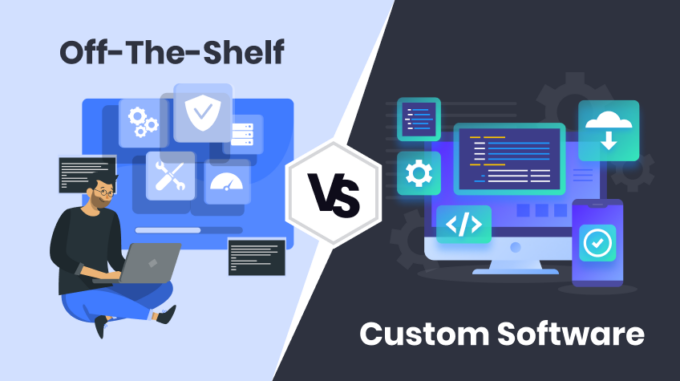In the digital age, choosing the right software can be a pivotal decision for businesses aiming to enhance efficiency and drive growth. The debate between custom software and off-the-shelf solutions is a longstanding one, each offering its unique set of advantages and considerations.
This blog post delves into a strategic comparison of custom software versus off-the-shelf solutions, examining key factors such as cost, scalability, functionality, and alignment with business objectives. By exploring these critical aspects, we aim to provide insights that will help decision-makers navigate the complex landscape of software selection, ensuring their choice supports long-term success and innovation.
When searching out new business software, companies need to weigh the pros and cons of custom software development services versus buying an off-the-shelf product. The good folk over at Modest explain that custom solutions provide specific capabilities aligned with an organization’s unique operations and goals. Meanwhile, ready-made packages offer standardized features at lower upfront cost. Understanding the key differences empowers informed software selection.
Upfront Cost and Development Speed

Source: weetechsolution.com
Off-the-shelf solutions require little or no initial development, allowing faster implementation than custom platforms. Buying a prepackaged application also cuts upfront coding costs. These advantages lead many companies towards standalone software or software-as-a-service options.
Nevertheless, while inexpensive to buy initially, these commercial products often carry recurring licensing fees and vendor lock-in that add up over time. When factoring in post-purchase costs, the total cost of ownership with off-the-shelf solutions often eclipses that of custom-built systems over long time horizons.
Integration With Existing Infrastructure
Integrating external solutions into current tech stacks can prove challenging and time-consuming. Commercial software lacks out-of-the-box compatibility with existing frameworks and databases. Significant IT efforts must be undertaken to customize and connect generalized third-party software capabilities to legacy systems. Custom software, however, inter-operates seamlessly with internal infrastructure right from the start.
Developers building custom-made platforms leverage intimate knowledge of current databases, interfaces, security protocols and more. The result is accelerated deployment and smoother internal alignment from custom-built tools purposefully designed to plug-and-play with the rest of the technology stack.
Local Control and Customization Ability

Source: startnearshoring.com
Off-the-shelf software delivers generalized capabilities unable to address specialized needs. Configuring commercial products is also limited to whatever customization tools their developers provide. Functionalities cannot be added or changed beyond constrained vendor-defined adjustment mechanisms that are ill-equipped to manage extensive process customization.
Custom systems, on the other hand, grant full control over platform direction and flexibility. Requirements evolve over time, particularly in dynamic, innovative industries. Custom software’s inherent agility empowers shifting core functionality to match changing business priorities on demand.
Competitive Differentiation
Rival firms often utilize the same common software packages, leading to commoditization of technology capabilities. The widespread adoption of generalized commercial platforms fuels parity rather than meaningful differentiation when it comes to customer experiences or internal operations.
Custom systems, however, create proprietary infrastructures that set a business apart from the very foundations upward. Homegrown platforms enable offering unique products, services and capabilities that standardized software restricts by design.
Enhanced User Experiences

Source: veritis.com
Standard solutions built for generalized needs often deliver poor user experiences that are ill-matched to actual workflows. Attempting to configure them to sync with existing operations results in complicated processes that are shoehorned into rigid system constraints that are not built for that business’s reality.
Custom software can deeply enhance and streamline UX when optimized around how specific organizations truly operate. Such targeted personalization pays dividends in stronger internal adoption, productivity gains, and employee satisfaction.
Long-Term Value Realization
Once deployed, custom software’s usefulness continuous compounding over years of reliable operation. Expert in-house developers maintain tight integration with surrounding infrastructure, ensuring responsiveness balancing upgrades with stability.
And as business needs change, custom platforms adapt right alongside for lasting alignment without reliance upon vendors’ willingness or ability to meet evolving needs. Commercial products, conversely, risk growing outdated and mismatched over time as an organization outgrows capabilities and redirects priorities beyond what the generalized software can stretch to address.
Scalability and Flexibility

Source: youtube.com
When evaluating scalability and flexibility, custom software stands out for its ability to adapt and grow alongside your business. It is designed with your specific needs in mind, enabling it to scale more effectively as your business evolves.
This contrasts with off-the-shelf solutions, which, although immediately accessible, may struggle to match the unique demands of your business over time due to inherent limitations in customization and scalability. The ability to tailor features and integrations in custom software means it can evolve in line with your business strategy, offering a significant advantage in dynamic markets.
Time-to-Market
The time-to-market is a critical factor in decision-making, especially in fast-paced industries. Off-the-shelf software provides a quick solution, being ready for immediate implementation, which is invaluable for businesses needing rapid deployment.
However, this speed comes at the expense of customization. Custom software, while requiring more time for development and testing, ensures that the final product is closely aligned with your business objectives. Balancing the urgency of deployment against the need for a tailored solution is essential for long-term success.
Maintenance and Updates

Source: 7t.co
Maintenance and updates are crucial for software longevity and security. Off-the-shelf software typically offers the convenience of regular updates and support from the vendor, reducing the burden on your internal team. In contrast, custom software demands ongoing maintenance, either from an in-house team or contracted developers, to ensure it remains up-to-date and secure. This requires a careful assessment of internal resources and the potential need for ongoing developer engagement.
Vendor Dependence vs. Ownership
Vendor dependence and ownership present a strategic choice. With off-the-shelf software, businesses rely on vendors for updates, support, and enhancements, which can introduce risks related to vendor stability and product direction.
Conversely, custom software affords full ownership and control, allowing businesses to dictate the software’s evolution. This independence from vendors can be a double-edged sword, necessitating a balance between the benefits of support and the value of autonomy.
Industry-Specific Requirements

Source: boostdigital.ba
For industries with unique regulations or operational needs, custom software offers a distinct advantage by being inherently designed to meet these specific requirements. This contrasts with off-the-shelf solutions, which may need additional customization or integration to achieve compliance, often resulting in increased costs and complexity. Tailoring software to industry-specific standards from the outset can significantly streamline operations and ensure compliance.
Total Cost of Ownership (TCO)
Understanding the total cost of ownership is pivotal in making an informed decision. Off-the-shelf solutions may appear cost-effective initially but considering the long-term aspects of customization, integration, and potential scalability limitations, custom software may offer a better return on investment.
Custom solutions are designed to fit your business precisely, potentially reducing the need for future modifications and offering a more strategic alignment with your business goals. Assessing TCO involves looking beyond upfront costs to consider the broader financial implications of each option over its lifecycle.
Conclusion
Custom software development brings strategic advantages that packaged solutions have difficulty rivaling. Custom systems deliver total cost efficiencies, seamless integration, extreme flexibility and differentiated capabilities over the long haul.
While requiring greater initial investment, custom software’s long-term value consistently outweighs short-term savings from buying prepackaged solutions. When ready to boost competitiveness across the entirety of their technology footprint, leaders confidently turn to custom software services.







